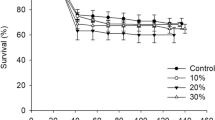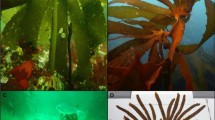Abstract
Pygmy rabbits (Brachylagus idahoensis) are one of only three vertebrates that subsist virtually exclusively on sagebrush (Artemisia spp.), which contains high levels of monoterpenes that can be toxic. We examined the mechanisms used by specialist pygmy rabbits to eliminate 1,8-cineole, a monoterpene of sagebrush, and compared them with those of cottontail rabbits (Sylvilagus nuttalli), a generalist herbivore. Rabbits were offered food pellets with increasing concentrations of cineole, and we measured voluntary intake and excretion of cineole metabolites in feces and urine. We expected pygmy rabbits to consume more, but excrete cineole more rapidly by using less-energetically expensive methods of detoxification than cottontails. Pygmy rabbits consumed 3–5 times more cineole than cottontails relative to their metabolic body mass, and excreted up to 2 times more cineole metabolites in their urine than did cottontails. Urinary metabolites excreted by pygmy rabbits were 20 % more highly-oxidized and 6 times less-conjugated than those of cottontails. Twenty percent of all cineole metabolites recovered from pygmy rabbits were in feces, whereas cottontails did not excrete fecal metabolites. When compared to other mammals that consume cineole, pygmy rabbits voluntarily consumed more, and excreted more cineole metabolites in feces, but they excreted less oxidized and more conjugated cineole metabolites in urine. Pygmy rabbits seem to have a greater capacity to minimize systemic exposure to cineole than do cottontails, and other cineole-consumers, by minimizing absorption and maximizing detoxification of ingested cineole. However, mechanisms that lower systemic exposure to cineole may come with a higher energetic cost in pygmy rabbits than in other mammalian herbivores.








Similar content being viewed by others
References
Angert, E. R., Frey, J. C., Pell, A. N., Berthiaume, R., Lapierre, H., Lee, S., Ha, J. K., and Mendell, J. E. 2010. Comparative studies of microbial populations in the rumen, duodenum, ileum and faeces of lactating dairy cows. J. Appl. Microbiol. 108:1982–1993.
Barnes, S., Prasain, J., D’Alessandro, T., Arabshahi, A., Botting, N., Lila, M. A., Jackson, G., Janle, E. M., and Weaver, C. M. 2011. The metabolism and analysis of isoflavones and other dietary polyphenols in foods and biological systems. Food and Function 2:235–244.
Betts, B. J. 1990. Geographic distribution and habitat preferences of Washington ground squirrels (Spermophilus washingtoni). Northwest. Nat. 71:27–37.
Blumenkranz, N. and Asboe-Hansen, G. 1973. A new method for quantitative determination of uronic acids. Anal. Biochem. 54:484–489.
Boyle, R. R. and McLean, S. 2004. Constraint of feeding by chronic ingestion of 1,8-cineole in the brushtail possum (Trichosurus vulpecula). J. Chem. Ecol. 30:757–775.
Boyle, R., McLean, S., Foley, W. J., and Davies, N. W. 1999. Comparative metabolism of dietary terpene, p-cymene, in generalist and specialist folivorous marsupials. J. Chem. Ecol. 25:2109–2126.
Boyle, R., McLean, S., and Davies, N. W. 2000. Biotransformation of 1,8-cineole in the brushtail possum (Trichosurus vulpecula). Xenobiotica 30:915–932.
Boyle, R., McLean, S., Foley, W., Davies, N. W., Peacock, E. J., and Moore, B. 2001. Metabolites of dietary 1,8-cineole in the male koala (Phascolarctos cinereus). Comp. Biochem. Physiol. Toxicol. Pharmacol. 129:385–395.
Boyle, R. R., McLean, S., Brandon, S., Pass, G. J., and Davies, N. W. 2002. Application of solid-phase microextraction to the quantitative analysis of 1,8-cineole in blood and expired air in a Eucalyptus herbivore, the brushtail possum (Trichosurus vulpecula). J. Chromatog. B 780:397–406.
Bray, R. O., Wambolt, C. L., and Kelsey, R. G. 1991. Influence of sagebrush terpenoids on mule deer preference. J. Chem. Ecol. 17:2053–2062.
Casarett, L. J., Doull, J., and Klaassen, C. D. 2008. Casarett and Doull’s Toxicology: The Basic Science of Poisons. McGraw-Hill, New York.
Cluff, L. K., Welch, B. L., Pederson, J. C., and Brotherson, J. D. 1982. Concentration of monoterpenoids in the rumen ingesta of wild mule deer. J. Range Manage. 35:192–194.
Connelly, J. W., Schroeder, M. A., Sands, A. R., and Braun, C. E. 2000. Guidelines for management of sage grouse populations and their habitats. Wildl. Soc. Bull. 28:967–985.
Cork, S. J. and Foley, W. J. 1991. Digestive and metabolic strategies of arboreal mammalian folivores in relation to chemical defenses in temperate and tropical forests, pp. 133–155, in R. T. Palo and C. T. Robbins (eds.), Plant Defenses Against Mammalian Herbivory. CRC Press, Boca Raton.
Dash, J. A. 1988. Effect of dietary terpenes on glucuronic-acid exretion and ascorbic-acid turnover in the brushtail possum (Trichosurus vulpecula). Comp. Biochem. Physiol. B Biochem. Mol. Biol. 89:221–226.
Degabriel, J. L., Moore, B. D., Shipley, L. A., Krockenberger, A. K., Wallis, I. R., Johnson, C. N., and Foley, W. J. 2009. Inter-population differences in the tolerance of a marsupial folivore to plant secondary metabolites. Oecologia 161:534–548.
FEDERAL REGISTER 2003. Endangered and threatened wildlife and plants; final rule to list the Columbia Basin Distinct Population Segment of Pygmy Rabbits (Brachylagus idahoensis) as endangered. Federal Register 68:10388–10409.
Green, J. S. and Flinders, J. T. 1980. Habitat and dietary relationships of the pygmy rabbits. J. Range Manag. 33:136–142.
Grigoleit, H. G. and Grigoleit, P. 2005. Pharmacology and preclinical pharmacokinetics of peppermint oil. Phytomedicine 12:612–616.
Haley, S. L., Lamb, J. G., Franklin, M. R., Constance, J. E., and Dearing, M. D. 2007. Xenobiotic metabolism of plant secondary compounds in oak (Quercus agrifolia) by specialist and generalist woodrat herbivores, genus Neotoma. J. Chem. Ecol. 33:2111–2122.
Johnson, M. K. and Hansen, R. M. 1979. Foods of cottontails and woodrats in south-central Idaho. J. Mammal. 60:213–215.
Johnson, A. E., James, L. F., and Spillett, J. 1976. The abortifacient and toxic effects of big sagebrush (Artemisia tridentata) and juniper (Juniperus osteosperma) on domestic sheep. J. Range Manag. 29:278–280.
Kelsey, R. G., Morris, M. S., Bhadane, N. R., and Shafizad, F. 1973. Chemical composition of sagebrush. 7. Sesquiterpene lactones of Artiemisia—TLC analysis and taxonomic significance. Phytochemistry 12:1345–1350.
Knick, S. T. and Rotenberry, J. T. 2000. Ghosts of habitats past: contribution of landscape change to current habitats used by shrubland birds. Ecology 81:220–227.
Kohl, K. D., Weiss, R. B., Dale, C., and Dearing, M. D. 2011. Diversity and novelty of the gut microbial community of an herbivorous rodent (Neotoma bryanti). Symbiosis 54:47–54.
Lawler, I. R., Stapley, J., Foley, W. J., and Eschler, B. M. 1999. Ecological example of conditioned flavor aversion in plant–herbivore interactions: Effect of terpenes of Eucalyptus leaves on feeding by common ringtail and brushtail possums. J. Chem. Ecol. 25:401–415.
Maccracken, J. G. and Hansen, R. M. 1984. Seasonal foods of blacktail jackrabbits and Nuttall cottontails in southeastern Idaho. J. Range Manag. 37:256–259.
Malecky, M. and Broudiscou, L. P. 2009. Disappearance of nine monoterpenes exposed in vitro to rumen microflora of dairy goats: Effects of inoculum source, redox potential, and vancomycin. J. Anim. Sci. 87:1366–1373.
Marsh, K. J., Wallis, I. R., Andrew, R. L., and Foley, W. J. 2006. The detoxification limitation hypothesis: Where did it come from and where is it going? J. Chem. Ecol. 32:1247–1266.
McLean, S. and Duncan, A. J. 2006. Pharmacological perspectives on the detoxification of plant secondary metabolites: Implications for ingestive behavior of herbivores. J. Chem. Ecol. 32:1213–1228.
Meyer, M. W. and Karasov, W. H. 1991. Chemical aspects of herbivory in arid and semiarid habitats, pp. 167–186, in R. T. Palo and C. T. Robbins (eds.), Plant Defenses Against Mammalian Herbivory. CRC Press, Boca Raton.
Miyazawa, M., Kameoka, H., Morinaga, K., Negoro, K., and Nobuo, M. 1989. Hydroxycineole: four new metabolites of 1,8-cineole in rabbits. J. Agric. Food. Chem. 37:222–226.
Miyazawa, M., Shindo, M., and Shimada, T. 2001. Oxidation of 1,8-cineole, the monoterpene cyclic ether originated from Eucalyptus polybractea, by cytochrome P450 3A enzymes in rat and human liver microsomes. Drug Metab. Dispos. 29:200–205.
Nagy, J. G., Steinhoff, H. W., and Ward, G. M. 1964. Effects of essential oils of sagebrush on deer rumen microbial function. J. Wildl. Manag. 28:785–791.
Ngugi, K. R., Powell, J., Hinds, F. C., and Olson, R. A. 1992. Range animal diet composition in south-central Wyoming. J. Range Manag. 45:542–545.
Provenza, F. D. 1995. Postingestive feedback as an elementary determinant of food preference and intake in ruminants. J. Range Manag. 48:2–17.
Sherman, P. W. and Runge, M. C. 2002. Demography of a population collapse: the northern Idaho ground squirrel (Spermophilus brunneus brunneus). Ecology 83:2816–2831.
Shipley, L. A., Davila, T. B., Thines, N. J., and Elias, B. A. 2006. Nutritional requirements and diet choices of the pygmy rabbit (Brachylagus idahoensis): A sagebrush specialist. J. Chem. Ecol. 32:2455–2474.
Shipley, L. A., Forbey, J. S., and Moore, B. D. 2009. Revisiting the dietary niche: When is a mammalian herbivore a specialist? Integr Comp. Biol. 49:274–290.
Sinclair, A. R. E., Jogia, M. K., and Andersen, R. J. 1988. Camphor from juvenile white spruce as an antifeedant for showshoe hares. J. Chem. Ecol. 14:1505–1514.
Skopec, M. M., Haley, S., and Dearing, M. D. 2007. Differential hepatic gene expression of a dietary specialist (Neotoma stephensi) and generalist (Neotoma albigula) in response to juniper (Juniperus monosperma) ingestion. Comp. Biochem. Phys. D Genomics Proteomics 2:34–43.
Sorensen, J. S. and Dearing, M. D. 2003. Elimination of plant toxins by herbivorous woodrats: Revisiting an explanation for dietary specialization in mammalian herbivores. Oecologia 134:88–94.
Sorensen, J. S. and Dearing, M. D. 2006. Efflux transporters as a novel herbivore countermechanism to plant chemical defense. J. Chem. Ecol. 32:1181–1196.
Sorensen, J. S., Turnbull, C. A., and Dearing, M. D. 2004. A specialist herbivore (Neotoma stephensi) absorbs fewer plant toxins than does a generalist (Neotoma albigula). Physiol. Biochem. Zool. 77:139–148.
Sorensen, J. S., McLister, J. D., and Dearing, M. D. 2005. Plant secondary metabolites compromise the energy budgets of specialist and generalist mammalian herbivores. Ecology 86:125–139.
Sorensen, J. S., Skopec, M. M., and Dearing, M. D. 2006. Application of pharmacological approaches to plant–mammal interactions. J. Chem. Ecol. 32:1229–1246.
Sorensen, J. S., Forbey, K. C., Tanquay, R. L., and McLeod, B. 2007. Tissue distribution of cytochrome P450 3A (CYP3A) in brushtail possums (Trichosurus vulpecula) exposed to Eucalyptus terpenes. Comp. Biochem. Physiol. C Toxicol. Pharmacol. 145:194–201.
Stanley, L. A., Horsburgh, B. C., Ross, J., Scheer, N., and Wolf, C. R. 2009. Drug transporters: Gatekeepers controlling access of xenobiotics to the cellular interior. Drug. Metab. Rev. 41:27–65.
Thines, N. J., Shipley, L. A., and Sayler, R. D. 2004. Effects of cattle grazing on ecology and habitat of Columbia Basin pygmy rabbits (Brachylagus idahoensis). Biol. Conserv. 119:525–534.
Ulappa, A. C. 2011. Nutritional and chemical factors shaping diet selection for two sagebrush obligates: Pygmy rabbits and sage-grouse. Thesis, Boise State University, Boise, Idaho.
Weddell, B. J. 1991. Distribution and movements of Columbian ground squirrels (Spermophilus columbianus (ord)): are habitat patches like islands? J. Biogeogr. 18:385–394.
Welch, B. L., Pederson, J. C., and Rodriguez, R. L. 1989. Monoterpene content of sage grouse ingesta. J. Chem. Ecol. 15:961–969.
Welniak, M. 2003. Amidation-sulfonation of selected unsaturated monoterpenes. Polish J. Chem. 77:203–210.
White, S. M., Welch, B. L., and Flinders, J. T. 1982. Monoterpenoid content of pygmy rabbit stomach ingesta. J. Range Manag. 35:107–109.
Wilt, F. M., Geddes, J. D., Tamma, R. V., Miller, G. C., and Everett, R. L. 1992. Interspecific variation of phenolic concentrations in persistent leaves among 6 taxa from subgenus tridentatae of Artemisia (Asteraceae). Biochem. System. Ecol. 20:41–52.
Yamamoto, K., Qi, W. M., Yokoo, Y., Miyata, H., Udayanga, K. G. S., Kawano, J., Yokoyama, T., Hoshi, N., and Kitagawa, H. 2009. Histoplanimetrical study on the spatial relationship of distribution of indigenous bacteria with mucosal lymphatic follicles in alimentary tract of rat. J. Vet. Med. Sci. 71:621–630.
Acknowledgments
We thank G. Radamaker, B. Davitt, and the Croteau Lab at Washington State University for assistance with data collection and chemical analyses. This project was funded by National Fish and Wildlife Foundation.
Author information
Authors and Affiliations
Corresponding author
Rights and permissions
About this article
Cite this article
Shipley, L.A., Davis, E.M., Felicetti, L.A. et al. Mechanisms for Eliminating Monoterpenes of Sagebrush by Specialist and Generalist Rabbits. J Chem Ecol 38, 1178–1189 (2012). https://doi.org/10.1007/s10886-012-0192-9
Received:
Revised:
Accepted:
Published:
Issue Date:
DOI: https://doi.org/10.1007/s10886-012-0192-9




